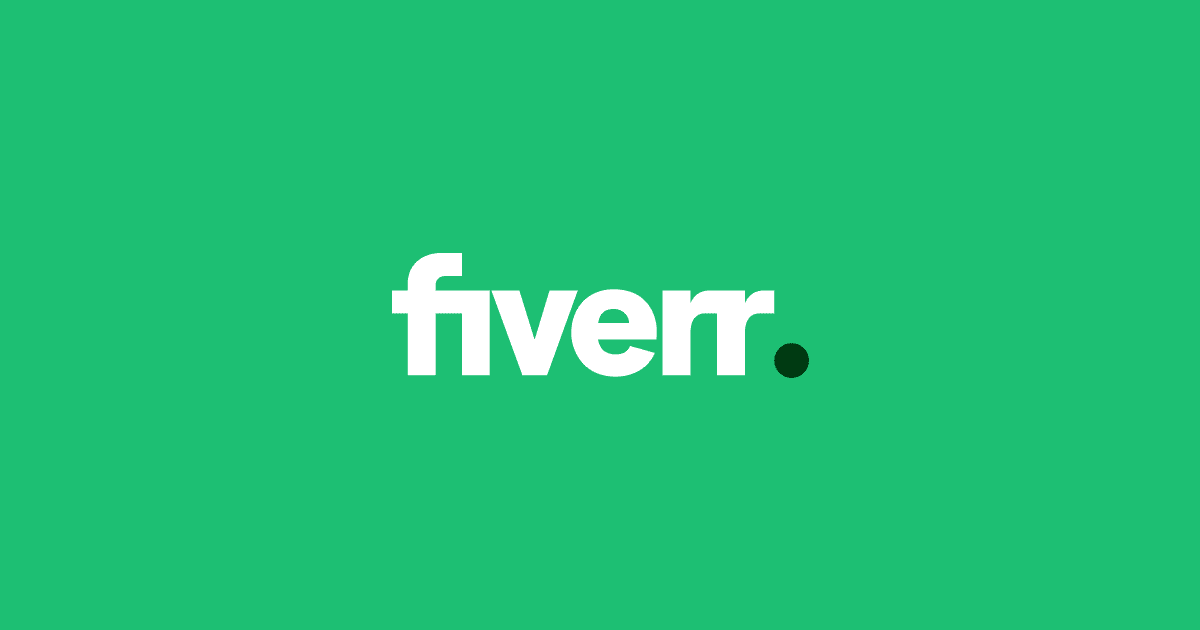The gig economy is roaring as more and more young people embrace the idea of freelancing for a living.
In the past, freelancing was a lot harder because it involved forming direct relationships with companies. But recent advancements in the freelance platform market have made it easier than ever to access opportunities from multiple companies at once.
Two of the most popular freelancing platforms in 2022 include Fiverr and Upwork, where people hire freelancers and remote workers for various tasks.
Here’s a quick comparison summary:
| FIVERR | UPWORK | |
| Pricing | 20% for all projects | 20% to start then scales down |
| Opportunities | Better for smaller projects | Better for larger projects |
| Customer Service | Limited help center | Robust support center |
| Upgrades | Fiverr Pro is free to apply | Upwork Pro costs $14.99 |
Keep reading for a closer look at how each freelancer platform stacks up to help you determine whether it makes sense to spend time looking for work on either.
or, jump straight to our in-depth Fiverr vs. Upwork comparison
What is Fiverr?
Fiverr is a digital marketplace where freelancers can connect with companies and offer their services.
The company was founded in 2010, giving them over a decade of experience in helping gig economy workers find jobs.
How Fiverr works
Here’s a breakdown of how to use Fiverr.
1. Have a skill
Like any freelance platform, the platform itself will only get you so far. Making money requires you to have a marketable skill.
This isn’t a platform for learning new trades or practicing writing, performing voiceovers, managing social media, or practicing video design. Don’t use Fiverr unless you’re proficient in graphic design, digital marketing, copywriting, or translation.
Fiverr is ultimately a marketplace, not a training center. And if you treat it as training, you’re liable to get poor reviews or wind up taking on a contract you can’t execute, thereby damaging your reputation as a freelancer.
If you need practice before using Fiverr, consider looking for courses on a site like Skill Success or interning for a company that can teach you the knowledge you need to succeed.
2. Sign up for Fiverr
Once you have a clear understanding of your skill, head over to Fiverr and sign up for their service. Fiverr is free to join, so you don’t have to worry about paying anything out of pocket upfront or subscribing to a service.
3. Create a gig
Once you’re up and running on the Fiverr platform, the next step is to create a profile and then a gig, which is basically an advertisement for a particular service.
Spend some time crafting an ideal description. Competition is fierce, and there’s no guarantee you’re going to get results either way.
To create a gig, select your subcategory and pick the one that matches your skillset. For example, you may choose the email marketing or blogging categories.
At this point, it’s a good idea to browse the site and see what your competitors (other Fiverr users) are offering. Look for ways to make your gig stand out from the rest and try to figure out an optimal price range and effective messaging for your services.
4. Wait for offers or pursue jobs
At this point, you have two options. The first option is to sit back and let companies find your gig. You can fill your gig with specific keywords to aid your discovery and make it easier for people to find you.
The main problem with this approach is that there are a lot of people on Fiverr. The platform has millions of users competing for a limited number of jobs. To stand out, you really have to be the best of the best freelancers.
Some highly skilled and experienced Fiverr users can do just fine letting companies find them. However, the majority of users would be better served by browsing gigs and applying directly. This is the most effective way to get noticed on Fiverr.
5. Do the work
When using Fiverr, the thing to keep in mind is that even after going through all the legwork of signing up, creating profiles and gigs, and hunting down opportunities, you still have to execute on any agreement.
Make sure you budget your time accordingly so that you’re in a position to deliver on the intended item after you accept a job. Most projects have firm deadlines to which you must adhere. You have to move quickly if you want to keep getting jobs.
6. Get paid
Once you complete a task on Fiverr and deliver the expected item, the client will review it to determine if it meets acceptable standards.
At the very end, the client will mark the project complete and pay you. Payment is transferred to your account once all deliverables are met. Of course, Fiverr will take a slice of your payouts, so that’s something to consider.
The Pros and Cons of Fiverr
Advantages
- Wide range of job categories
- Customize your own gigs
- Get paid through the app
Disadvantages
- High 20% commission to the app for all projects
- Can be hard for beginners to find work
- Poor customer support
What is Upwork?
Upwork is a marketplace for hiring freelancers. It’s a bit newer than Fiverr, having launched in 2015. That said, the platform has emerged as one of the leading outsourcing marketplaces and has a dedicated user base. Many Upwork freelancers are highly sought-after.
How to get started with Upwork
Here’s a rundown of how to get started with Upwork.
1. Have a skill
Upwork is no different from Fiverr in terms of expectations. Anyone is free to sign up, but proof of your skills and ability is left largely on the honor system.
In other words, if you say you can build a website or typeset an ebook, then you have to be able to deliver on the promised service. If not, you can accept a job, but you won’t get paid if the finished product isn’t up to par.
Make no mistake about it: Upwork is for professionals. It’s not a place for hobbyists.
2. Build a profile
Like Fiverr, Upwork also requires users to build profiles highlighting their skills and experience.
Users can also choose to share portfolios of their work and screenshots so that companies can quickly browse examples to determine if they want to move forward.
3. Set your pay
Determine your hourly pay rate in your profile, letting companies see what you charge in advance.
This is a cool part of the process; companies see how much you charge, so there generally isn’t much negotiation. They know how much it’s going to cost, and they only agree if there’s room in the budget.
If you aren’t sure about how to set an hourly rate, think about how long it takes you to do an average project. A reasonable or competitive beginner rate is $20 per hour. However, a solid freelancer with years of experience and niche expertise could charge more than that.
But you have to be able to clearly and effectively demonstrate your ability and value, or companies will typically balk and go for the cheaper option.
4. Bid for jobs and get paid
Once you create a profile, Upwork will highlight ideal jobs that match your skills. You can apply to them directly through Upwork and bid your price, or wait for companies to contact you with opportunities.
As you complete jobs, you can receive reviews and a Job Success Score. This is a great way for top freelancers to build credibility and obtain more gigs. And the higher your score goes, the more you can charge for your work.
The Pros and Cons of Upwork
Advantages
- Larger projects than Fiverr
- Better customer support
- Sliding scale means lower fees as time goes on
Disadvantages
- High 20% fee to start
- Heavy competition
- Bidding war could potentially mean underselling services
Fiverr vs. Upwork: A Comparison
As you can see, Fiverr and Upwork are pretty similar. But they do have their differences. With that in mind, let’s take a look at how they stack up against one another.
Pricing
Fiverr charges customers $1 for every $5 they bring in, i.e., a 20% commission. So, if you land a gig that pays you $100, you’re going to lose $20 to Fiverr.
Upwork, on the other hand, charges a service fee based on a percentage of the earnings that freelancers generate. This is based on a sliding fee of 20% for the first $500 that you bill your clients, and then 10% for total billings between $500 and $10,000, and 5% for total billings of more than $10,000.
Neither of these options is stellar. But that’s the price you pay for using a service that brings you paid gigs.
If you want to avoid these fees, test the open waters and find clients yourself. You can build rapport with clients through Upwork and Fiverr, then contract with them independently once you’ve established a relationship of ongoing work.
Granted, this opens up a whole new can of worms in terms of finding clients and billing for services.
Freelance opportunities
Both Upwork and Fiverr offer access to a variety of gigs across multiple industries.
However, Upwork seems to be the better platform for specialty projects or larger gigs that require advanced skills or knowledge.
Less experienced people tend to do better on Fiverr, which is more geared towards quick, low-paying gigs.
Customer service and dispute resolution
Fiverr offers a limited help center. There is no phone number or email address listed for help on Fiverr, but rather a request button for assistance and a link for checking on existing requests.
This can be a frustrating experience, especially when experiencing payment issues. If you need to speak with a representative, you’re going to be out of luck.
Upwork, on the other hand, offers a robust support center with personalized support and assistance. This is important when considering the fact that jobs tend to be more complex on Upwork. It definitely pays to have someone to chat with when help is needed.
Upgrades
Fiverr and Upwork both offer upgrades over their free platforms; Fiverr offers Fiverr Pro and Upwork offers Upwork Plus.
Fiverr Pro is still free. But to get accepted, you have to apply for their team to review. If accepted, you can charge more and work with better clients than you can find in the free version, giving you a more optimal experience.
Upwork Plus is a paid plan that costs $14.99. This provides access to 80 monthly connections and enhanced features like a custom URL for your profile, advanced reporting, and the ability to see what your competitors are offering for gigs.
In short, Fiverr Pro is better for experienced freelancers who want to land better gigs, while Upwork Pro is better for people who are just starting out and need advanced features to cut through the noise.
Upwork Pro’s subscription fee can be an issue, especially since they take an additional cut on top of it for every gig.
Tips for Freelancers
Freelancing is not easy
Some clients can be extremely picky and difficult to work with.
Part of excelling on a platform like Fiverr is being patient with customers and being able to take criticism. If you can’t handle that element, you probably won’t last very long in this line of work.
Freelancing is competitive
Making matters more complicated, freelancing is extremely competitive—especially in the post-pandemic gig economy where many people are working from home and looking for flexible freelance work.
To succeed on either Upwork or Fiverr, you’re going to have to put in some serious work. It requires charging low amounts at first, fighting to get jobs, and completing work in a very limited timeframe.
Some of the jobs that you take on won’t be pleasant to work on, either. But that’s just the nature of freelancing.
Don’t quit your day job just yet
Freelancers sometimes envision waking up one day without having to answer to a boss.
The reality is that it’s not that simple. First and foremost, the stress of not having a full-time job can make it harder to do quality work. If you’re constantly worried about making ends meet, it may negatively impact performance.
On top of that, there is the stress of having to actually locate jobs on Fiverr and Upwork, which is not guaranteed.
Consider finding jobs without Fiverr or Upwork
Few things are more frustrating than giving someone a cut of your hard-earned pay. But that’s essentially what you’re doing when working through a site like Fiverr or Upwork: surrendering a fee in exchange for them throwing work your way.
On one hand, these are gigs you may not be able to get on your own. On the other hand, that’s taking the lazy way out. And in business, the lazy way usually isn’t the best way.
Think of it this way: Companies are heading to sites like Fiverr or Upwork looking for talent. Find similar companies and go to them directly to offer freelance services. Negotiate your own contracts and form your own connections.
This approach is more challenging, but you can ultimately make more money this way.
The fact is that most experienced freelancers do not work with sites like Fiverr or Upwork. Try these sites as you’re starting out, but when you’re ready, graduate and walk your own path, whether that’s doing graphic design work, creating social media content, or selling SEO support.
Whatever you choose, you’ll be better off for it.
Frequently Asked Questions
How much does Upwork take from freelancers?
Upwork charges on a sidling scale, starting at 20% for the first $500 that you bill across all clients. Once you reach that level, Upwork charges 10% for total billings between $500 and $10,000. The third tier is 5% for total billings of more than $10,000.
Is Fiverr good for freelancers?
Fiverr is generally beneficial for freelancers who need access to quick side jobs. If you’re looking for quick one-offs, then this platform is ideal.
The main downside to using Fiverr is that it can be hard to find gigs. It’s competitive and companies typically approach the platform looking for the lowest price they can find, which works against freelancers since they’re competing globally.
Is Fiverr or Upwork better?
In terms of gigs, they are pretty equal as far as exposing freelancers to a wide network of clients across multiple industries. Fiverr is typically better for small projects, while Upwork is better for larger gigs.
What are some alternative freelance platforms to consider?
Alternative platforms for freelancing include Elance, oDesk, Freelancer.com, and 99designs. Spend some time vetting the various platforms to get a better sense of what else is out there. That said, Fiverr and Upwork are usually ranked in the top five.
As you go through each platform, you’ll notice that some offer skills tests to help source the most talented freelancers. Taking these tests can help set you apart from the pack. And some clients might even require them.
The Bottom Line
Upwork and Fiverr are both top freelance platforms. It doesn’t matter what type of work you do (e.g., graphic design, blogging, voiceovers, or website development), there are thousands of gigs across hundreds of niches on both websites. In time, by producing high-quality work, you could wind up transforming from a nine-to-fiver to making your own schedule.
Who knows? You might be a full-time freelancer before you know it, making a ton of money to do what you love every day… without ever having to answer to a boss.






No comments yet. Add your own